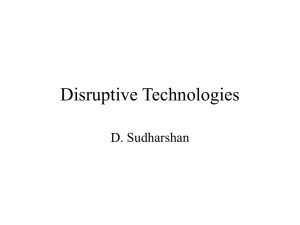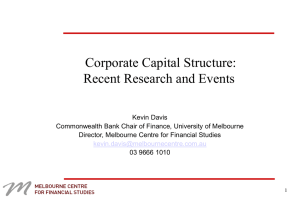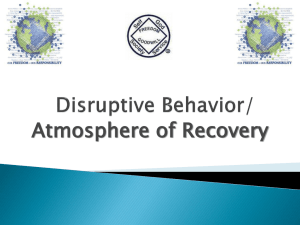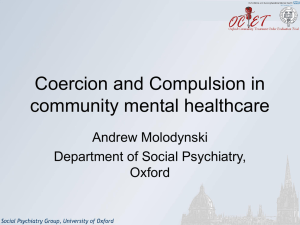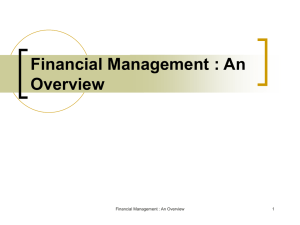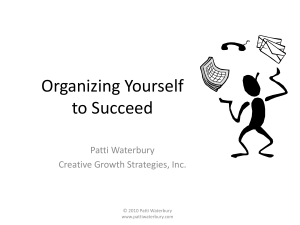Generating options for a new Business Model : Leverage the
advertisement
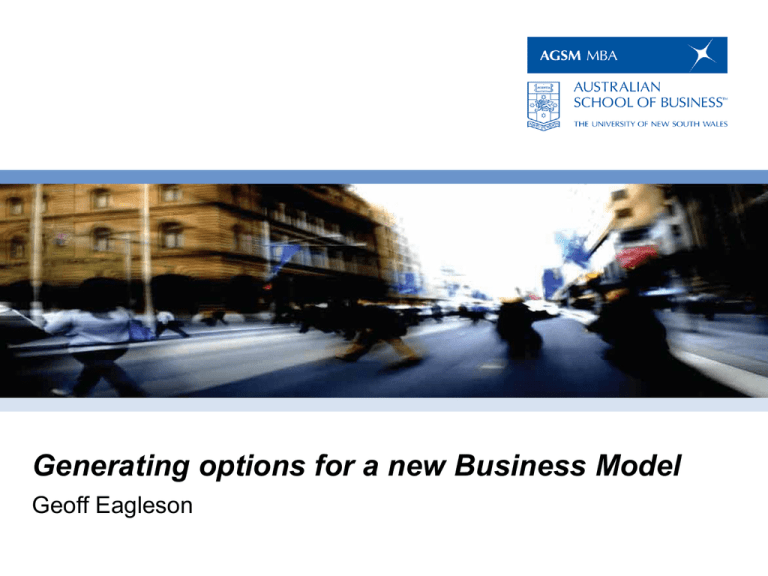
Generating options for a new Business Model Geoff Eagleson How can we generate options for a new Business Model whether for an organisation in trouble or for one that senses an inflection point in its performance? • Unstructured brainstorming is inadequate • Data mining is of limited value • Market Research that assesses demand for non-existent products is dubious • We know where to look: – Underexploited resources and capabilities – Untapped insight into customers – Future trends – Our and others’ experiences. • What we need is a process – it is all about framing. Source: Coyne, Clifford & Dye (2007) How do I generate options for a new Business Model? Leverage the experiences of self and others Leverage insights about future trends Business Model options Leverage existing R&C Leverage market intelligence Generating options for a new Business Model Road Map: How can we facilitate option generation? By leveraging: – Existing Resources and Capabilities • Audits of Resources and Capabilities – Market intelligence • Blue Ocean; Disruptive BMs – Insights about future trends • Scenario planning; Visioning; Enacting – Experiences of self and others • Reverse engineering; Intuition, Entrepreneurial approach. Applied to the AGSM in 1988 and an organisation chosen by your residential team Generating options for a new Business Model: Caveats • This is not a “numbers game”; this is “Do or die”. • This is more of an art than a science. • Beware of exiting your current core too soon. (Estimated to be10% of revenue stalls by Olson et al. (2008) – Reading 3). That is, make sure that you understand the real root causes of the decline. • Personal expectations, agendas and prejudices will play an important role. Generating options for a new Business Model: Leverage existing Resources. Resource Tangible (physical, financial, administrative, legal) 1. 2. 3. Intangible (IP, reputation, technology, culture) 1. 2. 3. Human (staff, customers, skills, know-how) 1. 2. 3. Strategic Importance Relative Strength Sustainable Value Capture VIRO: Appraising the strategic value of a Resource Valuable? – Relevant to customer needs; contributes to differentiation or cost advantage Imitable? – At risk of imitation by rivals, durability, mobility, substitutability Rare? – “Are you, or can you aspire to be best in class among the competition?” (Quinn & Hilmer, 1993) Organisation? – Organizational architecture, property rights, bargaining power, complementary resources or capabilities Source: J. Barney, 2007 - Reading 7 in SM 1 Auditing your resources: Questions to frame your analysis. • Identify the operational drivers through a du Pont analysis • What are your ‘crown jewels’? • What are your scarce resources? • “What business are we in?” • “What business could we be in?” • “What business should we be in?” Generating options for a new Business Model: Leverage existing Capabilities. • Analyse the value chain. Product related; customer related; corporate. (Zook (2007) – Reading 5) • Expose the asymmetries between your organisation and the competition. Who uses you rather than a competitor? What capabilities allow you able to serve these customers differently? Eisenstat & Foote (2002) – Reading 6) • What is the last function you would outsource? • Think beyond functions to organisational wide capabilities. (Miller, Capabilities Audit: Start with the Value Chain Firm Infrastructure Support Functions Human Resource Management Technology Development Procurement Margins Primary Functions Inbound Logistics Operations Outbound Logistics Marketing & Sales Service A “Core Capability” is a business process, strategically understood (Stalk, Evans & Shulman, 1992) Functional capabilities: FUNCTION CAPABILITY EXEMPLARS Corporate Management Financial management Strategic control Coordinating global SBUs Exxon, GE Emerson Electric ABB, Shell R&D Research capability Development of innovative new products Merck, Xerox Sony, 3M, Intel Product Design Design capability Apple, Swatch Manufacturing Efficient volume manufacturing Continuous Improvement in production Flexibility YKK Toyota Benetton, Nucor Marketing Brand management Coke, Proctor & Gamble Sales & Distribution Order processing speed & accuracy Efficiency and speed of distribution Amazon.com Federal Express Service Ritz Carlton Customer Service Organisational capabilities: • Continuously innovate – – • Control – – • Producing new information (J & J) Better analysing (Insurance) Sourcing and synthesising (Japanese trading houses) Learning from experience (Shell) Manage long-run structural advantages – – – – • Processes (McDonald’s) Behaviour (Professional service firm) Manage information – – – – • Product and services (3M) Processes (Toyota) Rivalry proposition (Oz building materials) Customer relationships (Pharmas) Supplier relationships (Bank insurance) Regulation (Merck). Renew – – Engagement (Woolworths) Development Sources: Stukey, Doman & Thwaites, 193 Turner & Crawford, 1998S Generating options for a new Business Model: Leverage market intelligence. • Leverage the asymmetries between your organisation and the competition: – Who uses you rather than a competitor? Why? (Miller, Eisenstat & Foote (2002) – Reading 6) • Use the Blue Ocean framework – Change the basis of competition – Serve those who are non-customers (Kim & Mauborgne (1995) – Reading x in SM 1) • Devise a disruptive Business Model – What are the barriers that constrain consumption? – Who could be customers? (Christensen, Johnson & Rigby (2002) – Reading 4) Blue Ocean :Yellow Tail’s “strategy canvas” Wine Connoisseur Uninformed Drinker Who Price-sensitive Drinker How Convenient Availability What did Yellow Tail Eliminate/Reduce/Raise/Create? Reduce Which factors should be reduced well below industry standards? Eliminate Which of the factors that the industry takes for granted should be eliminated? A New Value Curve Create Which factors should be created that the industry has never offered? Raise Which factors should be raised well above the industry’s standard? Eliminated Enological terminology and distinctions Raised Price versus budget wines Retail Store involvement Aging qualities Above-the-line marketing Reduced Wine complexity Created Easy drinking Wine range Ease of selection Vineyard prestige Fun and adventure Leverage market intelligence through a disruptive Business Model. Basic assumptions: • The pace of technological progress in almost every industry outstrips the ability of customers in any given tier of the market to make effective use of the improved versions of a product. Technologies that aren't good enough to address customers' needs at one point typically improve to provide more than enough performance for those same customers at a later point. • Companies earn attractive profit margins when they stretch their products up-market, targeting customers in a more demanding tier who are not yet satisfied by existing offerings. A down-market move toward customers who are already satisfied by available products yields profit margins that aren't nearly as attractive. • Innovations that help incumbent companies earn higher margins by selling better products to their best customers are sustaining, not disruptive. Sustaining innovations comprise both simple, incremental engineering improvements as well as breakthrough leaps up the trajectory of performance improvement. • In contrast to sustaining innovations, disruptive innovations appeal to customers who are unattractive to the incumbents. Although disruptive innovations typically involve simple adaptations of known technologies, entrants almost always beat incumbents at this game because established companies lack the motivation to win. Source: Christensen, Johnson, & Rigby,(2002) – Reading 4. The Model of Disruptive Innovation Customers not satisfied by current products Performance High Performance that average customers can utilize Customers over serviced by current products Low Source: Christensen and Raynor (2003) Time Generating options for a new Business Model : Leverage your experience and think like an entrepreneur. Sources of ideas for opportunities % 58.3 Prior work (previous role / employment, consulting project) Network 21.7 (social or business) Thinking by analogy Partner 11.3 8.7 Source: Timmons & Spinelli (2003) But be aware of cognitive biases: Novice entrepreneurs look for: Experienced entrepreneurs look for: Novel ideas Based on new technology Superiority of product or service Potential to change the industry Intuitively appealing Solving customers’ problems Favourable financial returns: positive cash flow, quick revenue generation Short sales cycles Manageable risk Potential for obtaining helpful input / collaboration from others Source: Baron & Ensley (2006) What personal attributes help an entrepreneur to identify opportunities? • Alertness A cognitive framework that assists entrepreneurs in being alert to opportunities. Those who possess such a schema show a tendency to search for and notice change and market disequilibria, to respond to information that does not match their current schemas, and to adjust existing schemas on the basis of such non-matching information. • Bisociation 20 Personal attributes sought in leaders of new growth opportunities: GE under Jeff Immelt requires five traits in the leaders of growth: – – – – – External focus Imagination and creativity Decisive Inclusive Deep domain expertise. Generating options for a new Business Model : Leverage the experiences of others. What do all the following products have in common? • Cirque de Soleil • Spider Man movies • Roller Blades. The question you ask determines the answer you get. • Reverse engineer and ask about a great idea: what question would have enabled me to see this opportunity first? Generating options for a new Business Model : Leverage insights about the future. What we see Reality Possible events http://www.petatv.com/tvpopup/video.asp?video=tyson_heflin&Player=wm The Basic Scenario Planning Process 1. Assess the current situation 8. Implement & monitor 2. Gather the data 3. Identify the driving forces 7. Define strategy & plans 6. Assess the implications for your org. 4. Generate alternative scenarios 5. Assess the implications for your environment Consider the AGSM in 1988. What options could it have considered to proactively transform itself? • Its core business was the full-time MBA. • It had been fully funded by the Commonwealth Government but that funding was expected to be slowly withdrawn. • It was the first educational institution that was given the right to pay above award wages from its own income, on the condition that it instituted a performance management system “with bite”. • What could it have done to protect its future? What were the options for a new Business model apart from introducing an Open Learning Program (the precursor to the EMBA). Consider the AGSM in 1988: Six teams, six tools: • Resource audit • Capabilities audit • Blue Ocean framework • Disruptive Business Model • Leverage the experience of self and others • Scenario planning Choose one of the organisations represented in your team and use a different tool from the one used earlier to generate options for a new Business Model. • Resource audit • Capabilities audit • Blue Ocean framework • Disruptive Business Model • Leverage the experience of self and others • Scenario planning References Baron & Ensley, 2006 Christensen, C.M. & Raynor, M.E. 2003, The innovator’s solution: creating and sustaining successful growth, Harvard Business School Publishing, Boston, Mass. Coyne, K. P., Clifford, P. G. & Dye, R. 2007, “Breakthrough thinking from inside the box”, Harvard Business Review, December, pp.71-78. Stalk, G., Evans, P. & Shulman, L. E. 1992, “Competing on capabilities: the new rules of corporate strategy”, Harvard Business Review, March-April, pp.57-69. Stukey, J., Doman, A. & Thwaites, R. 1993,”Distinctive and leveragable competencies”, in The case for core process design, McKinsey and Company, pp. 57-75. Timmons & Spinelli, 2003
